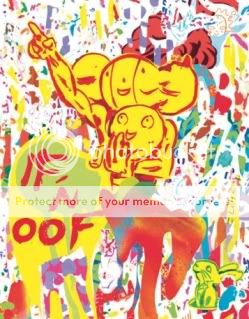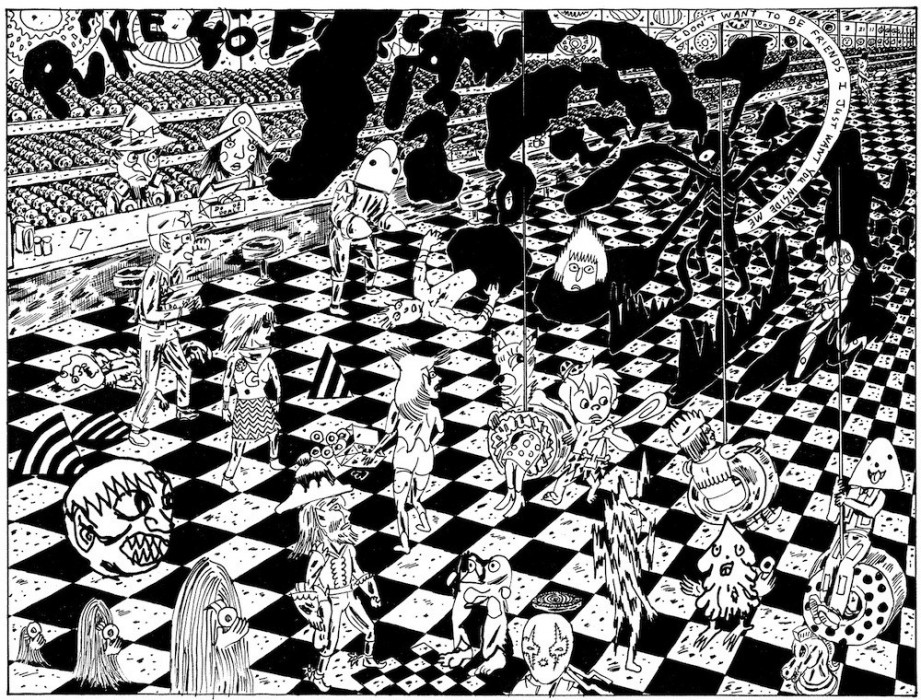Posts Tagged ‘Brian Chippendale’
“Puke Force” Is a Graphic Novel About Online Groupthink and Lone-Wolf Terrorism
February 21, 2016VICE: If I didn’t know any better I’d read this book as a warning to kids about the dangers of online. Not that it’s preachy, but the constant connectedness goes hand-in-hand with surveillance, and with the spread of destructive ideas.
Brian Chippendale: People are definitely reading a heavy warning about online activity in the book, and I think that’s one regret I have. I love the Internet. [Laughs] I’ve gotten so much practical use out of it: Selling prints, booking tours, saying hey to old friends—all that. But I do feel that even though I have an overt need for and warmth toward some social media, there is an undercurrent of energy on there that corrodes the soul.
What do you mean by “corrodes the soul”?
I think it’s the feeling that you’re not alone anymore. That should be a positive thing, right? But I think aloneness is important. It’s very important to get lost in your own head, not just get lost in the hive mind. As an artist, I need to venture inside to get at deeper meaning. Maybe new muscles for that are forming in younger people, new ways to go deep. I don’t necessarily think we are going to lose a generation to the internet. It’s an amazing tool. Pizza delivery drones, on the other hand? I’ll definitely be throwing rocks at them… and ordering pizzas.
Comics Time: Monster
January 21, 2011 Monster
Monster
Paul Lyons, Jim Drain, Michael DeForge, Michaela Zacchilli, Brian Ralph, Chuck Forsman, James Kochalka, Jim Rugg, Peter Edwards, Andy Estep, Oscar Estep, CF, Brian Chippendale, Blade, Keith McCulloch, Mike Taylor, Roby Newton, Edie Fake, Leif Goldberg, Keith Jones, Dennis Franklin, Jo Dery, Erik Talley, Beatrice McGeoch, Tony Astone, Mat Brinkman, Nick Thorburn, Melissa Mendes, Aaron DeMuth, writers/artists
Paul Lyons, editor
self-published (I think), October 2010
88 pages
$20
Buy it from PictureBox
They’re gettin’ the band back together, man! From out of the rubble of Fort Thunder rises the surprise 2010 revival of the gigantically influential Providence underground-art institution’s house anthology, featuring mostly-about-monsters work from all six of the Fort’s core cartoonists — Brinkman, Chippendale, Ralph, Drain, Lyons, Goldberg. Plus Andy Estep, Peter Edwards, Roby Newton, and a lot of other people you’ll see listed as having lived/worked/played in the Fort. Plus fellow-travelers like Providence’s CF and Jo Derry and Highwater’s James Kochalka. Plus Jim Rugg and Michael DeForge and Chuck Forsman and other leading lights of post-Fort alternative comics. And a reunion tour is exactly what it feels like.
Don’t get me wrong, there’s fine comics in this beautifully printed navy-blue-and-white package, many of which take advantage of its unusually large trim size. (We’re not talking Kramers Ergot 7 territory, but the thing is big. Think the Wednesday Comics hardcover.) Brian Ralph uses his comparatively clean cartoony style for a hilariously violent giant-robot comic, “Voltron from Hell,” basically, with huge panels and splash pages taking perversely pretty delight in mass destruction and death. The final panel of CF’s weird tale about an ambulance driver-cum-cat burglar who sneaks into the house of a woman with a mysterious disease actually made me jump — just a beautifully done little scare. Brian Chippendale’s story ties in with his Puke Force webcomic and gives him a chance to draw some villains at full splash-page size. I thought Chuck Forsman cut himself off at the knees a bit with his punchline ending, but until then his contribution was a creepy little thing that reminded me favorably of the urban legend my Delawarean wife recounted to me about the zoobies, the inbred mutant children of the DuPont family who would roam around the woods waylaying passers-by. There are insanely METAL full-page illustrations from Brinkman (who’s by now made a wonderful career of such things), Tony Astone, and Dennis Franklin — I mean, I laughed out loud at how fuckin’ devil-horns they were. And Lyons’s wraparound cover portraits of various barfing beasts is breathtaking, one of the most impressive single comics images of the year.
But in a way, the Fort Thunder aesthetic is a victim of its own success. I lost track of the number of good-to-great comics that came out this year bearing its influence, and those apples-to-apples comparisons make it hard for the work here, which I think all parties involved would admit was done more for fun than for tear-down-the-walls boundary-pushing, to stand out. In terms of anthologies alone, you could stand this one right between Studygroup 12, Closed Caption Comics, Smoke Signals, Diamond Comics, and Mould Map. Fort Thunder and the Providence scene’s DNA is now deeply embedded in an array publishers, including not just the late and lamented Highwater, Bodega, and Buenaventura, but also PictureBox, Secret Acres, Koyama, Nobrow, Pigeon, Gaze, and even the mighty Drawn & Quarterly. Moreover, whether you call it fusion or New Action or simply slap an alt- prefix in front of horror or SF or fantasy, Fort Thunder’s pioneering jailbreak of genre from the mainstream American comics prison has subsequently allowed it to become almost inescapable in smart-comics circles. Finally, Chippendale, Brinkman, Forsman, DeForge, CF, Fake, and Rugg are all in direct competition with work they put out elsewhere last year, most of which was more ambitious. And understandably so! Seriously, I’m not complaining — Monster is what I think it set out to be. It’s seeing Floyd get together for an awesome Live 8 gig, rather than seeing Waters and Gilmour working together again, and as such it’s more a treat for the fans than documentary evidence of why we became fans in the first place.
Comic of the Year of the Day: If ‘n Oof
December 27, 2010Every day throughout the month of December, Attentiondeficitdisorderly will spotlight one of the best comics of 2010. Today’s comic is If ‘n Oof by Brian Chippendale, published by PictureBox — if you’ve ever wanted to give the Fort Thunder aesthetic a shot, start here.
Hey, have you played the new Brian Chippendale game yet? I’m only exaggerating slightly when I say that reading each successive Chippendale/PictureBox graphic novel is like getting a new installment in your favorite video game series, one that shakes up the gameplay but still feels like an immersion in the original spirit you loved. From Ninja‘s giant-sized hardcover presentation, bright, buoyant black and white art, and slip-sliding layout; to Maggots‘ furtive samizdat scrawled-on-a-used-book origin, dense dark panels, and hiccuppy panel flow; and now to If ‘n Oof‘s doorstop thickness, manga-digest trim size, buddy-action-comedy tone, and one-panel-per-page design, they’re all uniformly and unmistakably Chippendale in story, art, and tone, but vastly different in terms of the sensory effect reading them has. They’re experiential, is what I’m saying–as much about the act of reading as about what is read.
Click here for a full review and purchasing information.
Comics Time: If ‘n Oof
December 13, 2010 If ‘n Oof
If ‘n Oof
Brian Chippendale, writer/artist
PictureBox, October 2010
800 pages
$29.95
Buy it from PictureBox
Buy it from Amazon.com
Hey, have you played the new Brian Chippendale game yet? I’m only exaggerating slightly when I say that reading each successive Chippendale/PictureBox graphic novel is like getting a new installment in your favorite video game series, one that shakes up the gameplay but still feels like an immersion in the original spirit you loved. From Ninja‘s giant-sized hardcover presentation, bright, buoyant black and white art, and slip-sliding layout; to Maggots‘ furtive samizdat scrawled-on-a-used-book origin, dense dark panels, and hiccuppy panel flow; and now to If ‘n Oof‘s doorstop thickness, manga-digest trim size, buddy-action-comedy tone, and one-panel-per-page design, they’re all uniformly and unmistakably Chippendale in story, art, and tone, but vastly different in terms of the sensory effect reading them has. They’re experiential, is what I’m saying–as much about the act of reading as about what is read.
If ‘n Oof has been billed as the most accessible of the three, and for good reason. There’s no tricky snake-style panel layout to follow: Every page is a splash page! The consequent ability of Chippendale to pretty much know for certain how the reader’s experience will be paced–there’s only so much time it’ll take you to take in each standalone image and either look at the next one or turn the page–enables him to perfectly mimic the beats of an action comedy: an out-of-nowhere save by an offscreen ally; “I’m gettin’ too old for this shit”-style takes when something particularly outlandish presents itself; big spectacular drawn-out leaps through high-rise windows to safety. There was one (hugely important to the story!) reference to Die Hard so explicit I laughed out loud, and hard–not least because it was an enormously emotionally effective reference to boot! Working in this format provides Chippendale with mainstream visual and rhythmic touchstones previously unavailable to him, and it pays off.
Chippendale appears to sense this, and returns the format’s favor by providing his most straightforward story yet. In place of the disjointed purgatorial wanderings of Maggots and the sprawling Deadwood-style story of a criminalized community of Ninja, you’ve got a pretty easy to grok post-apocalyptic sci-fi buddy road movie, with big-eared If and his tiny, mute companion Oof marching through various dangers en route to safety. There are none of the graphically violent or sexual asides or interludes with which Chippendale peppered his earlier works, either; aside from a memorably but not particularly shockingly gross encounter with a tribe of marauding monster-men (It Came from a Mat Brinkman Comic!!!), the violence here is mostly action-blockbuster R-rated level. And even in terms of individual visuals, there are images here that use a smoother line and more traditionally detailed construction than I’ve ever seen from the author before–vast cathedrals that look like something out of Craig Thompson’s Carnet de Voyage, long hallways that evoke the robotic geometry of Yuichi Yokoyama, fields of flowers that wouldn’t look out of place as the endpapers of a Charles Burns comic. They’re impressive moments, but they’re also funny moments for how accessible they are, as if Chippendale was saying “You think I need to do this jagged-edge markmaking shit all the time? Think again, pal.”
But as breezy and adventurous and action-packed and funny and fun as it all was, I started to wonder: “Where’s the bite?” For all his emphasis on comics-as-play, for all his character designs that look like a cross between forgotten He-Man villains and those little pink M.U.S.C.L.E.S toys, for all his obvious love of genre, Chippendale’s comics have a not-so-secret scathing heart–an indictment of contemporary capitalism, the way it disregards and dehumanizes individuals with the bad fortune of getting in the way of what its robber-baron bureaucrats consider progress. Was that going on here? Turns out the answer is yes after all, thanks to the slow-burn reveal, over the course of many chapters, of a familiar-feeling, haunting science-fiction trope. I’m not going to spoil it here, but suffice it to say it calls into question the notion of whether there really ever is breezy, adventurous, action-packed, funny fun to be had. Knowing the optimism Chippendale has displayed in his real life, to say nothing of the ending of Ninja, I suspect his ultimate answer would be “yes there is”–but it ain’t gonna be easy, and that’s even true in his most user-friendly game yet.


